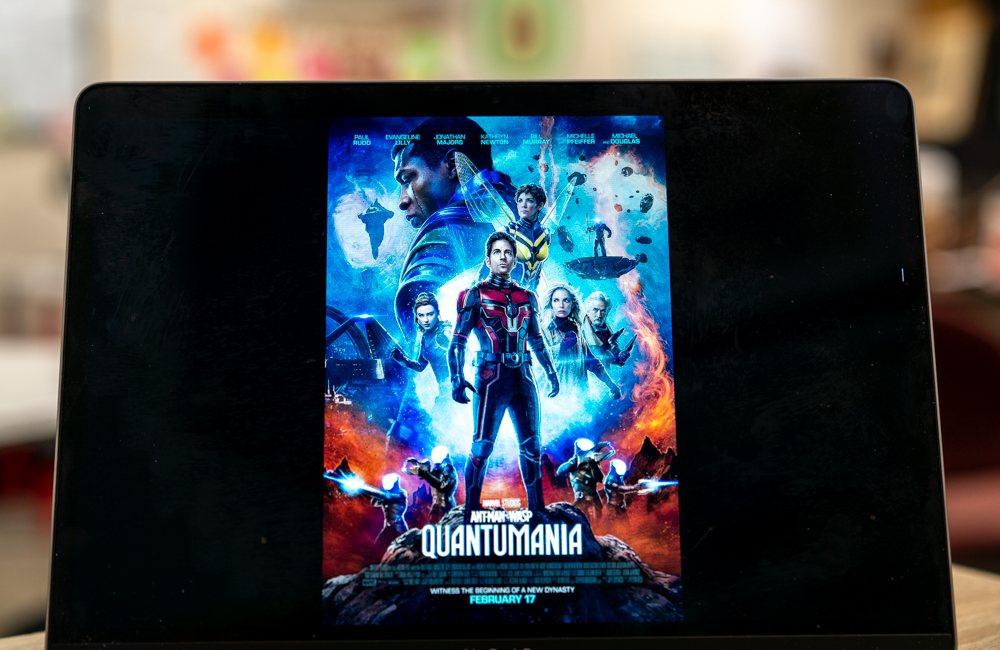
By: Felipe Belfort Marques, Johnathan D. Kindall and Jon Ollom
Taking place April 19-30 in the lower Manhattan neighborhood for which it’s named, the Tribeca Film Festival celebrated its 16th year showcasing groundbreaking independent filmmaking. The festival, which was started in 2002 with help from actor Robert De Niro, is an 11-day event featuring screenings, discussion panels and red carpet events. A number of standout movies made their worldwide debut at TFF this year, further cementing its importance in the film industry.
REVIEW: “Aardvark” touches on emotional themes, falls short in plot
Starring Jenny Slate, Jon Hamm and Zachary Quinto, “Aardvark” follows the story of Josh Norman, an emotionally challenged introvert who regularly suffers from hallucinations, and his interaction and relationships with his therapist and television star brother.
Belfort Marques: Everything from its sepia-filter visuals to its quirky little soundtrack make “Aardvark” seem like a run-of-the-mill indie film, yet its all-star cast and its attempts to stick to the three-act structure we know and love make it a bizarre amalgam of an indie film with a Hollywood rom-com — a mix as bizarre as its titular animal. There are character dynamics and plot, sure, but it all seems weirdly disconnected, leaving viewers to want a bit more — such as Josh’s (Zachary Quinto) repeated hallucinations, or Emily’s (Jenny Slate) skills as a therapist outside of helping Josh. Backstories are either teased — like Emily’s — or just outright given — Josh’s and Craig’s (Jon Hamm) — but none ever seem like enough. The indie quirkiness in “Aardvark” carries it past its shortcomings as a typical rom-com, but its lack of a full-bodied plot makes it feel incomplete somehow, and no amount of stars can save it from that kind of discomfort.
Ollom: “Aardvark” is an indie film to the fullest extent. It is a tidy story that touches on subjects of mental illness, failed relationships and loneliness. While some hallucinated characters and the general oddness of the lead add some spice to the script, the film is nothing exceptional. That is not to say “Aardvark” is lackluster or not entertaining. With an engaging script, moments of sharp comedy and solid performances from the three leads, the film is certainly worth watching. It is a fun, sometimes emotional, story with a feel-good ending that is welcome given how heavy the subject matter is. Yet, there is still a sense that the film could have done something more to separate itself from the long list of quirky indie flicks that came before it.
INTERVIEW: “Aardvark” director, actress discuss cast camaraderie
Coming from the world of playwriting and acting, “Aardvark” director Brian Shoaf made his feature film directing debut at TFF.
“To be able to open the film in a nearly 500-seat theater in New York City is a dream come true,” Shoaf told The Daily Free Press at the film’s red carpet debut. “Given that we are a truly independent film … for us to premiere somewhere where we can attract distributors is also immense.”
Shoaf explained how Quinto, who Shoaf has known for more than 20 years and whose credits include the modern “Star Trek” franchise and “American Horror Story,” joined the project in its early stages. Quinto stars in, produced and helped cast “Aardvark,” playing a role in obtaining some of the film’s other big-name talents like Hamm and Slate.
“Working with everyone has been a dream,” Shoaf said. “I think we had a nice little ecosystem on set.”
Dale Soules, who plays Lucille in the film, shared a similar love for the cast and the movie itself.
“I love the story of the film,” Soules said.
Her character, whom she defined as a “street person,” hangs out in an alley and hits up Quito’s character for cigarettes among other things. Soules emphasized the movie’s careful handling and exploration of mental illness as one of its strengths.
She characterized the film and her role in it as “very interesting from the point of view of an actor but also from the point of view of investigation of mental illness,” she said. “It’s done beautifully. It’s dealt with quite successfully.”
REVIEW: “Flames” follows passionate couple through ups and downs of relationship
Filmed over the course of five years, “Flames” is a half-documentary, half-narrative film that follows co-directors and real-life couple Zefrey Throwell and Josephine Decker. The film chronicles their relationship from romantic beginnings to the bitter end, exploring the way in which relationships don’t always end with a breakup.
Belfort Marques: “Flames” is a self-centered, creative movie about self-centered, creative people — a couple that was both madly in love and consumed by their sheer hatred of each other. And if hatred seems like too strong a word, it isn’t. It’s all too appropriate to describe a couple that spent an entire relationship constantly ragging on each other about how much they damaged each other’s lives in front of a camera, recording their every moment together. Not a scene goes by without Josephine and Zefrey constantly addressing how they hate each other or how they can’t seem to escape each other’s lives. For some, this might come off as absolutely annoying, for others, as a true, visceral representation of a long-term and slightly abusive relationship. But one thing’s for certain: these are absolutely terrible, pretentious, self-centered people, and they were terrible for each other.
Ollom: “Flames” is a creative docu-fiction, an audacious blend of home-style cinema and choreographed scenes with elements of cinema. With two zany, artistic people as the outlandish couple, the film is an entertaining and emotional love story about the death of romance. Later in the film, the couple reflects on their experience and why their relationship failed, yet there is a lot of telling and no showing. We can see moments of passion and argument but are not able to ascertain each couple’s emotional state until they speak into the camera, given explanations for things that were never there. There is also the question of how much of their relationship was real, and how much of us these two artists created for the purpose of the film. In the end, “Flames” provides romance that is both entirely real and entirely fabricated.
Kindall: On the surface, “Flames” is refreshingly, brutally and achingly real. It dives deep into Zefrey and Josephine’s relationship, sharing with the audience their ups, their downs and even their most intimate details. However, fairly early into the film, one begins to ask: Who’s filming these events? What’s real and what’s staged? “Flames” is so beautifully engaging because the characters ask themselves these same questions, and they don’t seem to quite know the answer either. The film is smile-inducing at times and gut-wrenching at others, but it toes the line between reality and fiction that it’s nearly impossible to look away from.
REVIEW: “Shadowman” depicts artist’s journey from rags to riches
In “Shadowman,” director Oren Jacoby explores the troubled life of street artist turned millionaire Richard Hambleton and the multiple rises and falls of his art career. Jacoby captures this often-forgotten artist’s life, from drug addiction and homelessness to million-dollar gallery openings.
Belfort Marques: Seeing Hambleton’s fall into artistic oblivion is sad and poetic — the artist is swept away by his own descent into drugs, paranoia and egotistic stardom much like his shadowy street works were swept away over time by the wind and rain. The documentary doesn’t frame any obvious protagonists or antagonists because we’re not meant to admire Hambleton’s tenacity in not selling out, just as we shouldn’t vilify his more famous contemporaries Jean-Michel Basquiat and Keith Haring for doing so — which shows just how complex of an artist, and more importantly how complex of a person, Hambleton really is. All the while, viewers will wonder whether Hambleton is alive or not, which brings up an important question: are artists only considered important after they die? And how awful is it if that’s the case? The film is a perfect showcase of Hambleton’s incredible art and the thought process of the man behind the pieces, someone who in his own words “had to get it out or else his brain will fall apart.”
Ollom: Documentaries about individuals often have difficulty engaging the audience, yet the personality and history of subject Hambleton makes for an entertaining nucleus for “Shadowman.” His own story arc as a star who falls from grace and then redeems himself practically writes the film itself. But Jacoby is able to create context for a story around Hambleton, making a piece that is less about an individual and more about the art scene of 1980s New York and the culture which surrounded it. “Shadowman” is very much a critique of the art industry itself, contrasting Hambleton’s deeply personal connection to the art he makes with the elitist, glamorous life many artists live. The film paints Hambleton as the last of a dying breed: an artist making art for the sake of making art, not for a profit. A bold and provocative documentary, “Shadowman” is an all-around excellent film.
Kindall: Hambleton’s story is ultimately a tragic one, and the film pulls no punches in making that known. “Shadowman” is at times hard to watch, not because of the filmmaking itself, but because of the ornery and ego-driven subject. Technically, however, the film shines as a well-crafted documentary. Relatively recent interviews with Hambleton and others in the contemporary art scene are spliced with archived footage and high-definition shots of hundreds of Hambleton’s pieces. All these moving parts serve to tell an interesting and cohesive story of an uncompromising artist that more people need to know.
REVIEW: Dark comedy “A Thousand Junkies” puts ominous twist on drug use
“A Thousand Junkies” is a narrative film from director Tommy Swerdlow that follows three Californian heroin addicts and their increasingly desperate attempts to “get well” throughout one trying day.
Belfort Marques: “A Thousand Junkies” is a film about clowns. No, not the ones in face paint, but the classic clown, the misanthrope left in the fringes of society, ambling about, trying to make a living. TJ (TJ Bowen), Tommy (Tommy Swerdlow) and Blake (Blake Heron) are, in this context, the ideal clowns: they stumble over each other in their search for their next big high, bumbling around suburban California, causing trouble wherever they go. All the while, we laugh at their efforts, at their “Seinfeld”-esque conversations, at their arguments over which spot is the best to peddle some dope, at their insults hurled at each other and at the world. But like any good clowns, TJ, Tommy and Blake have a darker, sadder side to them, and it is when this darker side reveals itself that we stop laughing with — or at — them and begin to truly pity them as the dope withdrawal takes hold of their bodies and minds. While the ending may practically excuse the throes of their addiction, the protagonists of “A Thousand Junkies” may be the quintessential modern Pagliacci, clowns fueled by their sadness, not helping the fact that to us — the outsiders — they seem funny.
Ollom: “A Thousand Junkies” is one of the most entertaining dark comedies in years. The dialogue is sharp and witty, and the entire film permeates with a bold sense of humor that is absurd enough to be funny, yet grounded enough to make it feel real. While the crafted characters and dialogue are hilarious, the subject matter of “A Thousand Junkies” is much darker than the lighthearted mood it creates. As the film progresses, it loses the energy and begins to seep into the heavier realities of addiction. The story-arc of the film — essentially a road trip that goes nowhere — mirrors the life of an addict perfectly: life going in circles, constantly searching for anything that will keep you moving in the same circle. When the credits roll, the viewer is left feeling entertained, but with a nagging sadness that lingers long after you leave the theater. A nearly flawless film, “A Thousand Junkies” is a stroke of comedic genius.
Kindall: The most troubling aspect of “A Thousand Junkies” is that there certainly exists a point in the film where one must stop laughing at the misfortunes of these characters, but where exactly this point lies is purposefully unclear. When does the quick and witty dialogue become somber instead of funny? Should we actually be rooting for the characters to score their drugs? The film is certainly constructed in a way that makes one hope they reach their goal. However, it doesn’t romanticize drug use in any way. Instead, it sheds light on the troubling questions regarding the line between funny and sad and laughing with and laughing at.
REVIEW: “Blame” emphasizes character development despite cliché backdrop
“Blame” is a dark teen drama about an outcast high school student who forms a secret relationship with her drama teacher after receiving the lead role in the high school play. Yet, when the rumors surrounding their relationship becomes public, drama ensues.
Ollom: “Blame” is a dark teen film that uniquely uses characters in ways most films do not. While the plot does drip into cheesy melodrama at times, it is able to maintain a sense of gravity through fantastic performances and well-written characters. Director, writer and star Quinn Shephard is a budding star in the film world, creating a movie that tells a story using the shifting arc of characters. Her own character, the shy, introverted Abigail, is presumed to be the protagonist of the story from the get-go, but about halfway through the film shifts focus to her love interest. Finally, the antagonist of the film, Melissa (Nadia Alexander), who at first seems like a generic high school bully ripped straight from “Mean Girls,” becomes the most dynamic character in the film and ends up as a redeemed hero. This unique storytelling method combined with a twisted tale of rumor and secrets make “Blame” one of the most engaging teen dramas in recent memory.
REVIEW: “The Endless” falls short, follows typical horror plot
“The Endless” follows the story of two brothers who, after escaping a cult as children, return to investigate nearly a decade later. The film follows the two as they come to terms with their past experiences in the cult and try to determine exactly what is happening in the isolated commune.
Belfort Marques: With its strange subject matter and downright bizarre execution, “The Endless” feels like your typical Hollywood thriller, with its tendency to slowly escalate the horror and explain it bit by bit so that viewers can come to the conclusion themselves, but it fails to explain some of the more crucial details of how its monster works – or what the monster even is, for that matter. “The Endless” looks like a white “Get Out” mixed with bits and pieces of “Coraline” but doesn’t quite get what made both those films so terrifying in the first place — the fact that there was some sort of rational explanation to its terror. Conversely, the production value of “The Endless” is on par with more mainline horror films, with a special mention going out to its rather impressive special effects. “The Endless” may not be the best of films, but directors Justin Benson and Aaron Moorhead definitely deserve to be picked up by a bigger distributor – in other words, their visions for horror shouldn’t end here.
Ollom: “The Endless” is a film that has an excellent concept but is poorly executed. Sloppy in its narrative, the film morphs from a story about the relationship between two brothers to an ugly story about cults and monsters, while also attempting to bend time and space. Combine this with static characters, a litany of useless subplots, and unexplained storylines, and the audience would have an easier time making sense of a roadmap flipped upside down and drawn in crayon. Any sense of action or drama flies out the window because one is too focused on trying to make sense of the story to actually enjoy it. The film tries to follow in the footsteps of films like “Interstellar” and “Inception” which were able to deftly handle shifts through time and space. Instead, “The Endless” falls flat on its face.
Kindall: “The Endless” reads like an attempt at a disorienting, mind-bending horror and thriller along the lines of “Inception” or nearly any Stephen King novel, but it never quite reaches the intelligent heights of the stories it tries to imitate. It leaves a lot of hanging question which, at first, seem mysterious and intentionally ambiguous, but after a while seem like oversights and anachronisms. Despite regularly poor execution, however, the film is incredibly enjoyable in the moment. Although it tries and fails to imitate other films like it, there is, a fair amount of originality and storytelling to be found here.
REVIEW: “Literally, Right Before Aaron” exudes familiar, intelligent plot
“Literally, Right Before Aaron” is a romantic comedy that shows Adam (Justin Long) attending his ex-girlfriend’s (Cobie Smulders) wedding, where she’s marrying a new man she’s known for less than a year.
Kindall: “Literally, Right Before Aaron” isn’t a groundbreaking film. It’s a few artistic steps removed from the some of its more challenging and independent contemporaries at the festival. However, it’s inarguably an enjoyable film. The two leads perform well in their roles, acting in a genre they’re obviously accustomed to. The story is familiar enough to be comfortable but intelligent enough to not be predictable. “Literally, Right Before Aaron” is easy to watch, and it felt the most like a typical theater movie than almost anything else at the festival. Its story is succinct and well-told, and its relatively short run-time helps it not feel sluggish or over-ambitious. Heartwarming and genuinely funny, “Literally, Right Before Aaron” has a good chance of joining an ever-growing list of beloved American rom-coms.
REVIEW: “My Friend Dahmer” explores age-old question of nature versus nurture
In “My Friend Dahmer,” director Marc Meyers explores the forces that turned high school loner Jeffrey Dahmer (Ross Lynch) into the infamous serial killer he’s known as today. Former Disney Channel star Lynch stars as Dahmer in this film based on Derf Backderf’s graphic novel of the same name.
Kindall: In some cases, it can be profoundly disturbing to know how a story ends, and director Marc Meyers’ “My Friend Dahmer” is one of these cases. Ross Lynch gives an amazing, breakout performance, making future serial killer Jeffrey Dahmer relatable and easy to sympathize with. At many points in the film, one even feels encouraged to cheer for Dahmer, as if hoping and willing could prevent the tortured yet hopeful high schooler from turning into the killer he becomes. However, a nagging uneasiness underscores the whole film. How long until Dahmer breaks? In the film, Meyers explores the age-old question of nature versus nurture through the lens of a serial criminal. Can you make or even breed a murderer, or are the urges always inside of them? The film doesn’t give any definitive answers to these questions, but it offers a unique, rarely seen angle to the true crime genre that asks hard and perhaps unanswerable questions about the relationship between murder, society and serial crime.
REVIEW: “Psychopaths” lacks concrete plot, makes up with gore
Following the death of an imprisoned madman who promises chaos after his execution, “Psychopaths” is a horror film that follows the stories of multiple serial criminals in one small town and their exploits across one bloody night.
Belfort Marques: Too artsy to fully embrace the schlock that comes with the slasher horror genre and at the same time too schlocky to be truly considered an art house film, “Psychopaths” uses its psychedelic imagery to truly confer a sense of madcap chaos as its killers gleefully murder their way through the film’s quaint, 60s-suburb-esque setting. While visually impressive, “Psychopaths” left its plot purposefully ambiguous, making it more a gory gallery of the grotesque than a film with a solid beginning, middle and end. All in all, while it seems unlikely that “Psychopaths” will make its way to the classics of its genre, it certainly seems like it would gain its own set of fans.
Ollom: “Psychopaths” is a stylish nightmare of a film. Director Mickey Keating expertly uses lighting and color to create a colorful, yet horrifying vision. Every few minutes is like a new exhibit, as the director plays with different styles, moods, camera techniques and uses interesting audio and visual combinations that fill one with a permeating sense of dread. Shattering any sense of narrative, the film tells three separate stories that are loosely connected with hints that they may tie together, but never do. In this way, the film seems chaotic and frustratingly open-ended. While “Psychopaths” may be a movie that doesn’t go anywhere narratively, it still gives the viewer a hell of a time.
Kindall: “Psychopaths” aims to confuse, and it does its job a little too well. There’s a want and a need for the all the various plot points to tie together, but they simply don’t. The discomfort left by this lack of resolution could be counted as one of the film’s strengths, but it doesn’t excuse “Psychopath’s” obvious flaws. In a particularly brilliant moment of self-awareness, the narrator of the film suggests that, “maybe chaos is just chaos,” but the narrative confusion of “Psychopaths” compounds to a point where it detracts from the film overall.
REVIEW: “A River Below” emphasizes gravity of the extinction of Amazon River dolphin
Award-winning documentarist Mark Grieco’s “A River Below” follows Brazilian actor Richard Rasmussen and Colombian biologist Fernando Trujillo as they try to save the endangered Amazon River dolphin at all costs — but it also shows those affected in the wake of their actions.
Belfort Marques: “A River Below” may be about the Amazon river dolphin on the surface, but much like the Amazon River itself, there is much more bubbling beneath. More accurately, “A River Below” is a film about perspective — in it, no one is 100 percent right or wrong. Rasmussen and Trujillo have their reasons to have done what they did, but viewers are also presented to the consequences, good and bad, and the effect that their activism had on their own lives, but also on the local fishermen communities, the economy, national laws, and yes, on the dolphins as well. It not only challenges you to not just side with Rasmussen, Trujillo or the fishermen, but also to approach similar situations with this multi-faceted worldview. When Rasmussen asks the director “who are you to [judge] me?” he is also asking the audience: Who are we, really, to judge whether his and Trujillo’s actions were too extreme? Conversely, who are we to judge the fishermen as to how they reacted to Rasmussen and Trujillo? One leaves “A River Below” with a weight on their conscience beyond mere “An Inconvenient Truth” — style environmental awareness — viewers are forced to confront with the fact that all sides can be right and wrong at the same time, and that actions have consequences beyond what anyone could predict.
REVIEW: “True Conviction” sparks empathy in audience for wrongly accused
Longtime documentary director Jamie Meltzer’s “True Conviction” tells the story of Christopher Scott, Johnnie Lindsey and Steven Phillips, three exonerated ex-cons from Dallas who decide to open their own investigative agency to save others who were wrongly accused.
Belfort Marques: The main strength of“True Conviction” is its commitment to showing detail in every aspect of Scott’s, Lindsey’s and Phillips’ lives. While showing every single aspect of both cases may seem boring to some, it’s crucial in helping viewers understand the lengths that the three men go to in order to fully prove these men are indeed innocent. Conversely, showing Scott’s relationship with his son and grandson or Lindsey’s and Phillips’ personal trials and tribulations may seem like just filler, but it helps to show why they do what they do — so that other people don’t miss out on their lives like they missed theirs. This double-view into Scott’s, Lindsey’s and Phillips’ lives makes “True Conviction” a much more emotional film — the three are very invested in saving others, but through the process they continually save themselves. It becomes practically impossible to see into these men’s lives and exit the movie without feeling for them, while also reconsidering just how unfair the prison system is to make innocent men like these suffer for false accusations.
Kindall: The issues at hand in “True Conviction” are not easy to tackle. Should ex-inmates with their own host of troubles really be the one’s tackling these cases? No one else is fighting for these men, so Scott, Lindsey and Phillips will have to do. Can current inmates be taken at their word when they claim they’re innocent? It’s these three’s job to find out. The film is engaging, at times acting as much as a true crime drama as a documentary, and impactful. It touches and plays upon every available emotion and may possibly draw a few tears to a number of eyes.

























































































































Ben Dennis • Apr 27, 2017 at 6:50 pm
Johnathan – You do a masterful job with all of your reviews…They are well-written, introspective, and, to me, they are objective…They are easy to read, and, even though one may not have seen the movie, he/she seems to feel that he/she has…Great job all around….